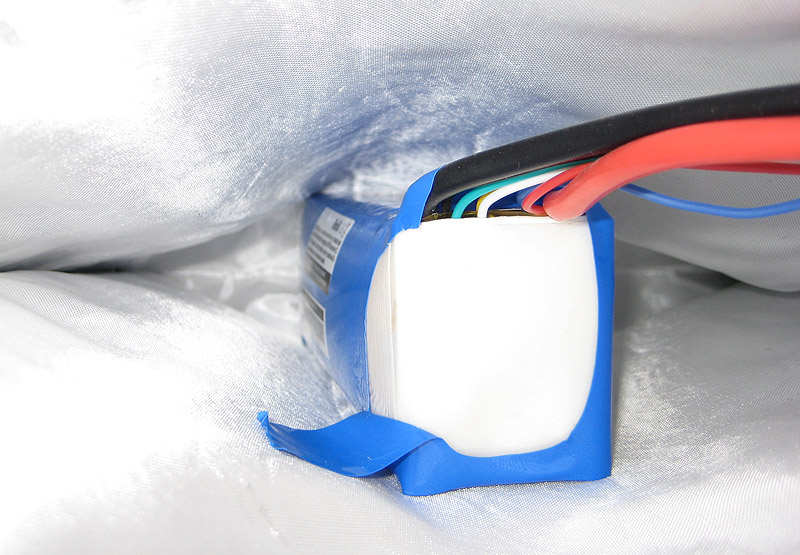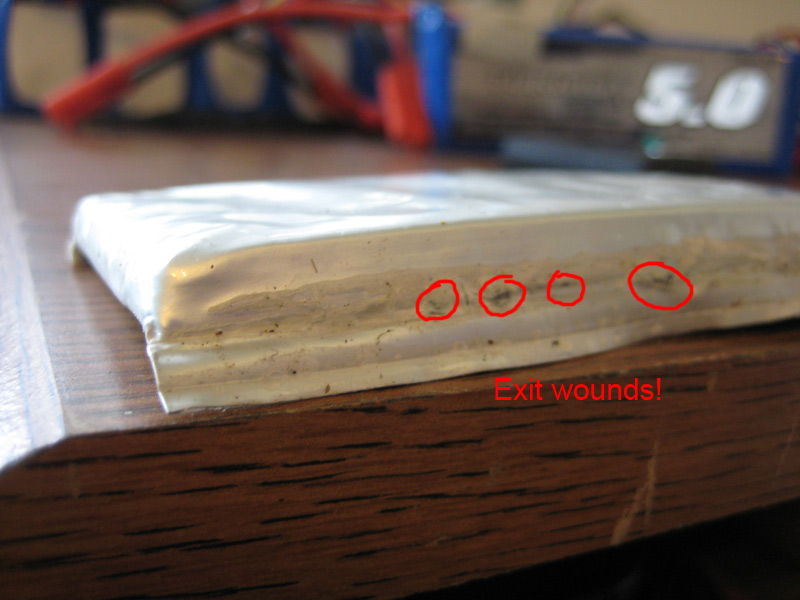So, it happened. A high discharge 18650 finally competes with the turnigy multistar packs.
I did some math in another thread and would like to show the difference.
Note: the INR18650-25R cell sheet is attached to this post.
Samsuing rates the 0.2C capacity at 9.38whrs and an average voltage of 3.66v.
Samsung rates the 8C capacity at 7.84whrs and an average voltage of 3.18v.
Therefore, 8C actually blows 17% of your battery energy as heat. Yeah, you don't want to run it at 8C. You don't want to run a turnigy multistar at 10C either because it will do basically the same thing. We're not going to talk about 8C or 10C usage here because thermal problems develop in both packs and life is shortened dramatically.
At 8C, it looks like the battery cycle life degrades pretty damn fast too. After 200 cycles, you've got a 2.0AH cell. A multistar would probably fare worse with this abuse, providing 100 cycles to 80% instead of 300 cycles to what.. 80%?
Let's do some math on the whrs/kg, eh? given that each cell is 44 grams..
0.2C energy delivered = 9.38whrs / 0.044kg = 213whrs/kg - nice!
4C energy delivered = 8.79whrs/kg / 0.044kg = 199whrs/kg - okay, that's still decent!
8C energy delivered = 7.84whrs / 0.044kg = 178whrs/kg - kinda lackluster.
Compare this to a turnigy multistar:
Christofer Parham ( icecube57 ) found out that there was extra amp hours hanging out in his. His 16AH packs came out at about 16.7AH on average. This is actually typical for RC Lipo. I have personally seen 5.2-5.3AH come out of a 5AH pack before - right before the first cell hits 3.0v at a meager 1C discharge.
http://www.endless-sphere.com/forums/viewtopic.php?f=14&t=61672&start=200
Nominal voltage is 3.8v as shown by discharge various graphs of RC Lipo cells at low C rates such as 1C and the turnigy multistar has the same discharge curve as all the other lipos. Hobbyking rates their capacity at much higher than 1C. Hobbyking says the cell is 3.7v nominal, but that is probably accounting for the fact that people run it closer to the max C rate. I'm going to use 3.75v nominal to do this calculation.
16.7 x 3.75v x 6 cells = 375.75 whrs.
4C energy delivered - 375.75 whrs / 1.920kg = 195.7whrs/kg.
It would be safe to assume that this pack probably delivers 200whrs/kg at 1C.
The Samsung 25R is slightly lighter than the multistar pack in weight, but the Samsung 25R is going to take up more volume and does not have as strong of a power output, especially as you increase the C rate. Once you hit 4C on the 25R, you are neck and neck to the turnigy multistar. To build a 1kw-hr pack with the Samsungs, you have to weld 111 cells together as well. You can can build a 1123whrs multistar pack by simply building a 3 connection series harness because 95% of the wiring and welding is already done. So the multistars have a huge advantage here.
If you do not require high discharge and are happy to be in 2C-3C land, the Samsung is prolly the better choice for lowest weight, but you're still going to take a tiny hit in the amount of battery you can cram in a given space. Pouch cells just use space better.
Safety advantage goes to the Samsung of course. Samsung says that the cell will smoke if damaged/abused/etc. RC Lipo packs like the turnigy multistars will most often produce fire as a failure mode.
Price? the multistars are 378whrs / $119 ( USA hobbyking price ), which would be $314 per kw-hr. That is very low for consumer-pricing.
If a Samsung 25R is 9.38whrs / $6, then the cost is $639 per kw-hr.
It is my opinion that multistars are still the king of the hill right now for overall value if you are building a large battery pack that needs to produce up to 100 amps. But 18650's have basically caught up to multistars power/energy density, and building a long range, high power bike is now finally an option with them.
I did some math in another thread and would like to show the difference.
Note: the INR18650-25R cell sheet is attached to this post.
Samsuing rates the 0.2C capacity at 9.38whrs and an average voltage of 3.66v.
Samsung rates the 8C capacity at 7.84whrs and an average voltage of 3.18v.
Therefore, 8C actually blows 17% of your battery energy as heat. Yeah, you don't want to run it at 8C. You don't want to run a turnigy multistar at 10C either because it will do basically the same thing. We're not going to talk about 8C or 10C usage here because thermal problems develop in both packs and life is shortened dramatically.
At 8C, it looks like the battery cycle life degrades pretty damn fast too. After 200 cycles, you've got a 2.0AH cell. A multistar would probably fare worse with this abuse, providing 100 cycles to 80% instead of 300 cycles to what.. 80%?
Let's do some math on the whrs/kg, eh? given that each cell is 44 grams..
0.2C energy delivered = 9.38whrs / 0.044kg = 213whrs/kg - nice!
4C energy delivered = 8.79whrs/kg / 0.044kg = 199whrs/kg - okay, that's still decent!
8C energy delivered = 7.84whrs / 0.044kg = 178whrs/kg - kinda lackluster.
Compare this to a turnigy multistar:
Christofer Parham ( icecube57 ) found out that there was extra amp hours hanging out in his. His 16AH packs came out at about 16.7AH on average. This is actually typical for RC Lipo. I have personally seen 5.2-5.3AH come out of a 5AH pack before - right before the first cell hits 3.0v at a meager 1C discharge.
http://www.endless-sphere.com/forums/viewtopic.php?f=14&t=61672&start=200
I just did 4C testing on the multistars 16AH... This is 64A. So 4C puts this pack right at it max discharge capacity. Starting to see diminishing results. The pack was able to stay above 3.5v a cell for 15.7AH. It still delivered a full 16.7AH down to 3.0v.
Nominal voltage is 3.8v as shown by discharge various graphs of RC Lipo cells at low C rates such as 1C and the turnigy multistar has the same discharge curve as all the other lipos. Hobbyking rates their capacity at much higher than 1C. Hobbyking says the cell is 3.7v nominal, but that is probably accounting for the fact that people run it closer to the max C rate. I'm going to use 3.75v nominal to do this calculation.
16.7 x 3.75v x 6 cells = 375.75 whrs.
4C energy delivered - 375.75 whrs / 1.920kg = 195.7whrs/kg.
It would be safe to assume that this pack probably delivers 200whrs/kg at 1C.
The Samsung 25R is slightly lighter than the multistar pack in weight, but the Samsung 25R is going to take up more volume and does not have as strong of a power output, especially as you increase the C rate. Once you hit 4C on the 25R, you are neck and neck to the turnigy multistar. To build a 1kw-hr pack with the Samsungs, you have to weld 111 cells together as well. You can can build a 1123whrs multistar pack by simply building a 3 connection series harness because 95% of the wiring and welding is already done. So the multistars have a huge advantage here.
If you do not require high discharge and are happy to be in 2C-3C land, the Samsung is prolly the better choice for lowest weight, but you're still going to take a tiny hit in the amount of battery you can cram in a given space. Pouch cells just use space better.
Safety advantage goes to the Samsung of course. Samsung says that the cell will smoke if damaged/abused/etc. RC Lipo packs like the turnigy multistars will most often produce fire as a failure mode.
Price? the multistars are 378whrs / $119 ( USA hobbyking price ), which would be $314 per kw-hr. That is very low for consumer-pricing.
If a Samsung 25R is 9.38whrs / $6, then the cost is $639 per kw-hr.
It is my opinion that multistars are still the king of the hill right now for overall value if you are building a large battery pack that needs to produce up to 100 amps. But 18650's have basically caught up to multistars power/energy density, and building a long range, high power bike is now finally an option with them.




